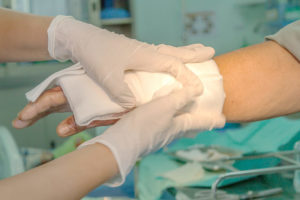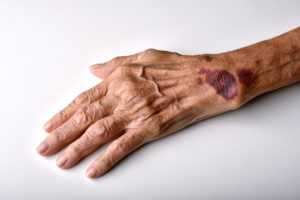Degloving Injury

A degloving injury is exactly what it sounds like. The flesh gets peeled from your body like removing a glove. These injuries can leave the accident victim with permanent disability and disfigurement from the damage to the soft tissue.
As a result, people who suffer degloving injuries often have substantial medical bills for reconstructive surgery or even amputation. They also suffer immeasurable pain and mental anguish as a result of their injuries.
Read on to learn about how a degloving injury happens and how you can get compensation for its effects.
Table of Contents
What is the Structure and Function of Your Skin?

The soft tissue that covers your skeleton includes structures from your immune, musculoskeletal, circulatory, and nervous systems. These systems work together to provide movement, feed your cells, and protect your body from injuries and diseases.
The outermost layers of flesh form your skin. Your skin is your body’s largest organ.
The skin serves several purposes, including:
- Protecting your body from microorganisms
- Forming a water-tight barrier to prevent fluid loss
- Producing vitamin D from sunlight
- Collecting touch sensations, including pressure, temperature, and texture
- Regulating body temperature by producing sweat
Below the skin is a layer of fat that stores energy and insulates your body.
Muscles and connective tissue sit below the fat layer. The connective tissue holds the skin and fat to the muscle. The muscles provide strength and movement and connect to bones through tendons.
Your brain controls your muscles with nerve signals. Nerves run throughout your muscles and terminate in nerve endings in your skin. Motor signals travel from your brain to your muscles to cause them to contract and relax.
The nerve endings in your skin translate touch sensations into nerve signals. Sensory signals travel from your skin and muscles to your brain to provide information about the state of your body and your environment.
All of the cells in your body need oxygen for cell metabolism. Cell metabolism gives cells the energy to perform their functions. Without oxygen, cells die.
Blood vessels run to your bones, muscles, and skin to supply oxygen. They also carry waste products, like carbon dioxide, away from your cells.
What Are the Two Types of Degloving Injuries?
Degloving injuries happen when a force on your flesh causes it to peel from the underlying tissue. Degloving injuries can take two forms:
Open Degloving Injury
An open degloving injury happens when the flesh gets peeled from your body. The flesh forms a flap. The flap may remain connected to your body, or it may separate from the underlying flesh.
Common causes of open degloving injuries include:
- Workplace accidents involving body parts caught in moving machinery
- Pedestrian accidents where the pedestrian gets dragged
- Car accidents where a body part smashes through a window
Another common cause of open degloving injuries is when jewelry gets caught on something and strips the flesh.
Closed Degloving Injury
A closed degloving injury happens when traction on your flesh causes it to separate from the underlying layer. You perform an analogous action when you use the friction of your fingers to slide the page of a book and separate it from the underlying pages.
A closed degloving injury does not leave an outwardly visible tear, but the tear under the flesh can fill with fluid.
These injuries can happen in the same ways as open degloving injuries. They just fail to involve a sharp edge to tear the flesh open.
What Are the Effects of a Degloving Injury?
Since the flesh gets separated from the underlying tissue, the blood vessels that fed the flesh in the flap often get torn or severed. As a result, degloving injuries often bleed profusely. But more importantly, since the blood supply was lost, the tissue in the flap will begin to die.
This will happen whether you have an open or closed degloving injury. One of the risks of a closed degloving injury is that it has no outward signs except some bruise-like discoloration. As a result, these closed injuries often have a delayed diagnosis, resulting in dead tissue.
Doctors often cannot restore circulation to the degloved flap. As a result, degloving injuries often result in:
Amputation
Doctors will often remove the flap of skin since it will die without circulation. If they try to reattach it but fail, the dead flesh will develop gangrene and endanger the accident victim’s life.
Scars
Scars happen when replacement cells grow over a wound. Replacement cells are thicker and less elastic than your original cells.
After doctors amputate the flap of flesh, they may use skin grafts to cover the open wound. As the degloving injury heals, it can develop disfiguring scars.
Nerve Damage
When flesh gets torn from your body, it will take the nerve endings with it. The remaining flesh will often lack the sensory nerves that were in the upper layers of flesh that you lost. You may lack the sensation of touch in the injured area even after the injury heals.
Infection
Infections happen when microorganisms get into the body through an open wound. A degloving injury poses a severe risk of infection because of the size of the open wound.
Doctors will clean the wound before dressing it. They may also administer antibiotics to reduce the risk of infection.
What Compensation Can You Seek for a Degloving Injury?
If you suffer a degloving injury due to the negligence of another party, you can seek injury compensation. This compensation will cover your economic and non-economic losses.
Your economic losses cover the financial effects of your injury. Medical bills, lost wages, and diminished earning capacity due to permanent disabilities all qualify as economic losses.
Your non-economic losses include all of the ways your injury diminished your quality of life. Examples of non-economic losses include your pain, mental anguish, disfigurement, scarring, and inability to participate in activities or perform tasks. A degloving injury could leave you disabled and disfigured. To learn more about the compensation you can seek for your degloving injury, contact or call Stephens Law at (817) 420-7000 to schedule a free consultation.
Stephens Law Personal Injury | Wrongful Death | Truck Accidents
1300 S University Dr # 300
Fort Worth, TX 76107
(817) 420-7000


